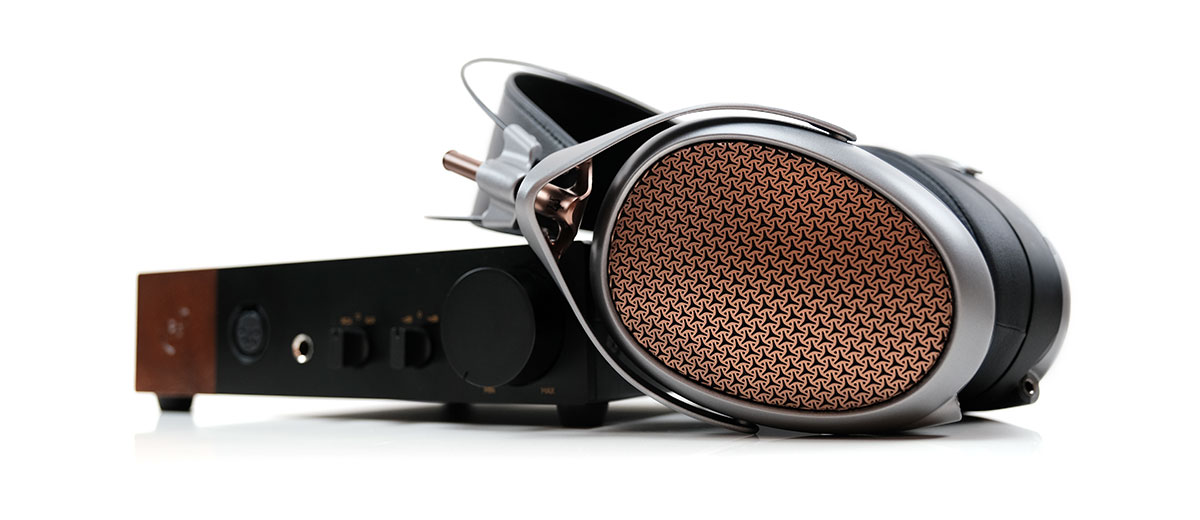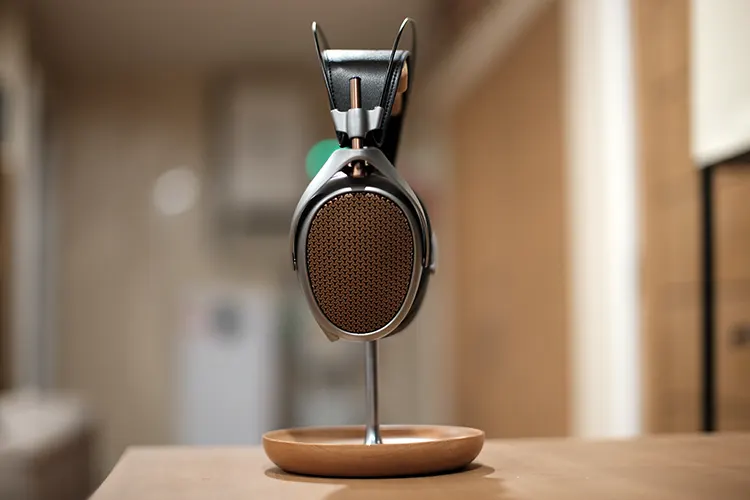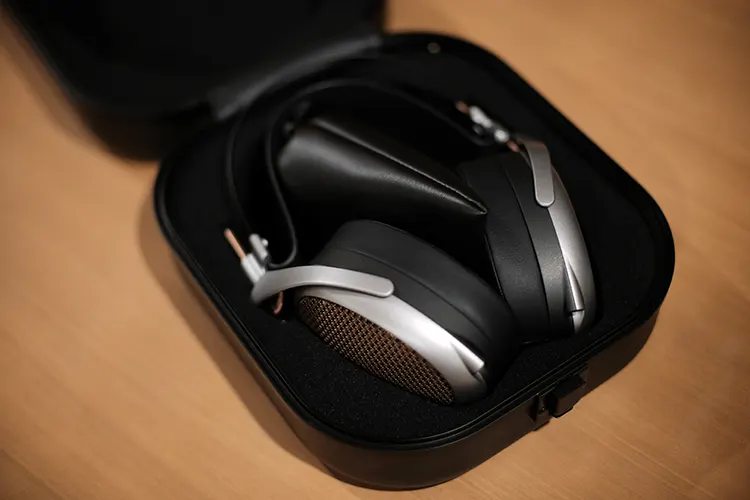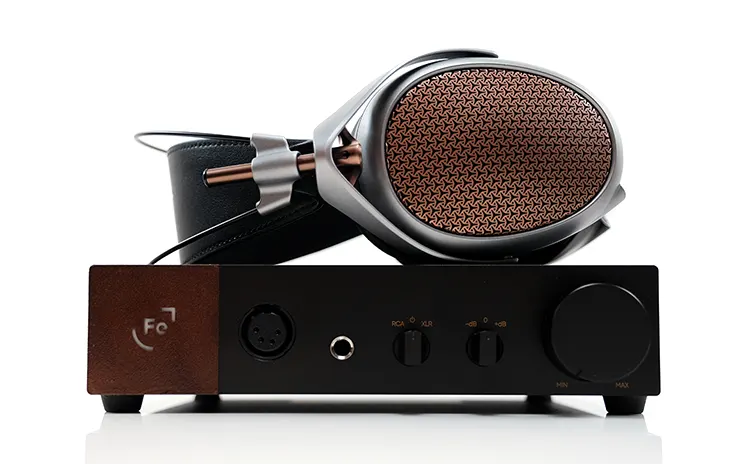Sound Impressions
The following sound impressions of the Meze Audio POET were completed using a mix of the Ferrum WANDLA GSE/OOR desktop combo and the Chord Electronics Hugo 2 portable DAC/amp.
Summary
Whilst I would still consider the original Empyrean as a level-up courtesy of that larger MZ3 driver, the POET is the one headphone Meze Audio has recently launched that comes closest to capturing its ‘spirit’.
This is a smooth-sounding, relatively balanced sound signature, easy on the ear and relatively easy to drive. It has some nuanced adjustments to the bass response and the highs to give it a more relaxed tuning than the more aggressive Liric II and Empyrean II.
The POET also avoids being labeled a ‘lesser Empyrean’ with a stronger treble fill and a slightly flatter bass response. It provides a little more midrange contrast while retaining a good sub-bass response free of excessive upper-bass bloat.
If you are used to the QWRM-tuned from the Liric II, then the POET highs will sound smoother and sweeter. The bass response is more neutral in quantity yet still fairly deep-reaching with less aggressive vocal imaging.
While I find the POET to offer a smaller and more compressed soundstage compared to the flagship Meze headphones, Liric II owners will quickly pick up on the effects of switching to a more open acoustic environment with a smoother dissipation of notes and much-improved headroom over its closed-back sibling.
Perhaps that is the POET’s Achilles heel, that diminished sense of openness compared to the higher-end headphones. Considering where it is positioned in Meze’s line-up, it should be no surprise that there is a slight drop in technical capability.
Those worried that a rise in impedance means a more challenging headphone to drive shouldn’t worry. Whilst slightly less efficient than the Empyrean II and Elite, it’s more sensitive than the Liric II, meaning most amps and decent portable rigs will handle the POET fairly easily.
Frequency Response
If you are used to the extended bass shelf of the Liric II, then the POET’s more restrained FR from around 300Hz downwards might come as a slight surprise.
Yes, it’s controlled, eschewing that familiar bloom from previous models in favor of a flatter, tighter sound. That is not to say that POET has a lean low-end, but of all Meze headphones I have tested to date, it’s the most neutral in terms of quantity right down to 20Hz.
Post 80Hz up to around 500Hz, there is a gentle lift with a further bump around 1-2k. It is just enough to describe the response curve as slightly above neutral and a factor in the POET’s smoother tonal coloration.
From 2k-8k, there is some gain, but it is just 1-2 dB shy of neutral, which is where I tend to prefer my vocal positioning in an otherwise intimate soundstage. The warmth helps create a relatively fulsome yet relaxed vocal tone and one that is not as in-your-face as the Liric II’s more walled-in presentation.
Where it also differs from the Liric II is its gentler upper-mids and lower-treble tuning from 3-7k, which might be the intended effect of the AMTS technology.
The POET FR runs up to 2-3 dB lower in amplitude from 3k-7k, meaning the Liric II’s percussion and vocals can sound spikier with more noticeable harmonic dissonance and sibilance with brighter amplification.
The POET is not as attenuated in the highs as the Empyrean. There is some gentle nudging around 7k-8k, introducing a bit of fizz and contrast on percussion and vocal performances, but this can be source-dependent.
Tube amps such as the Cayin HA-2A and HA-300MK2 keep the POET highs sounding sweet and sparkling, whereas drier amps such as the Topping DX9 deliver a rawer tone.
Staging & Dynamics
The POET has a reasonably deep and tall soundstage, one that I find airier and more open-sounding than the Liric II’s closed-back equivalent.
However, compared to the flagship offerings, such as the Empyrean II and the Elite, it can sound constrained and narrow with less space and slightly reduced clarity.
What I enjoyed, though, was the tighter bass response. The lack of upper-bass bloom provides better insight into the POET’s sub-bass performance, so although it’s not as weighty, it’s nicely defined and with decent bass-to-mids separation. A solid case of ‘less is more.’
Amp/DAC matchups do have a pronounced effect on the staging bias of the POET. For example, the ONIX Mystic XP1 will improve the depth and enhance the POET’s fundamental frequency, but at the cost of shifting the energy lower down and producing a darker sound.
I found myself gravitating to setups that did something more in terms of width and headroom, such as the airy Chord Electronics Hugo 2 and the excellent Spatial DSP filter from Ferrum’s WANDLA GSE edition DAC.
In both instances, the POET responded quite well in terms of improved space and instrumental layering within that smaller soundstage.
Synergy
Efficiency
The Meze Audio POET is rated at 55Ω for impedance with an SPL of 101 dB SPL/mW at 1 kHz. Like most Meze Audio headphones, I do not consider the POET a difficult planar headphone to drive.
The impedance is a little higher than their 32Ω flagship Elite offering. That paper difference plays out ever so slightly in reality when volume-matching the two headphones from my OOR/WANDLA GSE desktop rig.
However, it’s not a huge gap, just a gentle nudge upwards a ‘notch or two’ rather than a large dial swing.
Compared to the Liric II, it is a little easier to drive, but it is a similar observation to the difference from the Elite comparison with the POET just a notch or two below the Liric II’s comfortable volume setting with the same setup.
What you are up against a little is the 6.35mm terminated stock cable, which makes pairing a little trickier for portable use. There are no currently available dongles with a 6.35mm jack, and DAP choices are few and far between, with the FiiO M17 a standout choice with its 6.35mm PO.
You will have better luck with portable amps. Units such as FiiO’s Q7, Chord’s Hugo 2, Shanling’s H7, and the ONIX Mystic XP1 are some of the options that offer a default 6.35mm output.
If you have a 6.35mm to 3.5mm adaptor, you can include a lot more there, including dongles. However, bear in mind that the output power and channel separation from an SE connection are normally reduced on portable gear, save for something like the Mojo 2, which is SE only.
Portable Pairings
I tested four mobile sources with stock 6.35mm outputs, including the Hugo 2, the ONIX Mystic XP1, Shanling’s H7, and the FiiO M17 DAP.
If you want the weightiest, deepest bass response from the POET, then the XP1 is my recommendation. It delivers a deep and powerful sound signature with some additional vocal presence and decent contrast on the timbre to ensure everything is well-defined.
The cons of the XP1 pairing are the lack of treble extension and staging width compared to the Hugo 2. It sounds darker and more centered than the Chord pairing.
If you want the most spacious soundstage and the clearest and tonally accurate treble, with excellent mids imaging, then the Hugo 2 is the right pick. The only caveat with the POET/Hugo 2 pairing is a very neutral bass response, which is a factor in its airier sound signature.
The H7 and the M17 sit somewhere in between. The H7/POET presentation is wider and airier than the M17 pairing but lacks some necessary tonal contrast that doesn’t help the relaxed vocal imaging stand out as much.
The M17 does better with contrast, but the mids staging is narrower, and of the four tested sources, the POET sounded the driest from the M17. Still, the bass weight was very good, and the vocals were more forward-sounding than the H7. I would also say the POET sounded more resolving with the M17 than the H7.
Desktop Pairings
My primary pairing focus was the POET’s vocal presence, treble smoothness, and bass impact.
I selected 2 tube amps, the Cayin HA-300MK2 and the lower-end HA-2A, and 2 solid-state alternatives, the Ferrum OOR and the DX9. I also used the DX9 as my DAC for the HA-2A, the Holo Audio Spring 2 for the HA-300MK2, and the WANDLA GSE for the OOR.
The tube amps did best for treble smoothness, keeping the POET timbre to the sweeter, more relaxing side. The HA-300MK2 fleshed out the POET vocals better than the HA-2A, providing more width and staging depth.
The HA-2A delivers a full bass and a smooth set of highs from the POET pairing. However, vocals were more neutral in imaging, and the staging was not as immersive as the bigger HA-300MK2.
Both amps have impedance selectors so you can tweak the POET sound a bit more. Medium impedance is more dynamic, with stronger vocal presence from both amps, but the treble overtones will sound more invasive. Low impedance is the more soothing of the two options on both amps.
The solid-state amps offered a punchier bass response from the POET with less bloom or warmth.
You will hear more lower treble from the POET with solid-state than the warmer tube highs. However, the DX9 treble overtones with the POET sounded sharper and drier than the OOR pairing.
If you are using the WANDLA GSE, then I suggest tuning the tube and spatial DSP on, as it makes a huge difference to the POET treble performance and staging depth.
The Spatial DSP from the WANDLA really helps with the narrow staging traits of the POET, creating more space and improving the layering substantially compared to the flatter DX9 presentation.





